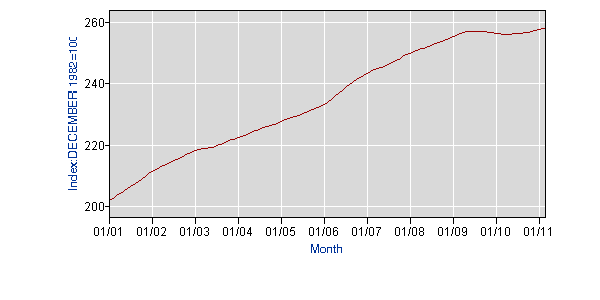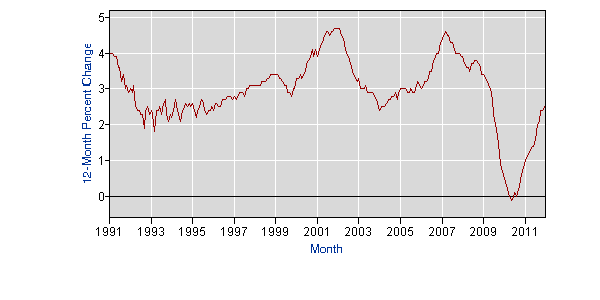May 05, 2011
USA Today told readers that rents are now rising rapidly because of an improving job market. That should raise suspicions, since the job market is not really improving much.
If we check out the data from our friends at the Bureau of Labor Statistics (BLS), we don’t see much of story. Here’s the trend for owner’s equivalent rent (OER). This is a measure of rent that looks at the implicit rental value of owner occupied homes. The BLS index for OER has risen by less than 1 percent over the last two years. There’s not much of a story of rising rents here.

We get a little different picture if we go to the BLS index for rent proper which measures the increase in the price paid by people who are actually renting their home. This shows that rents have risen by 1.4 percent over the last two years, with most of the increase coming in the last year.

The likely reason for the difference is that the index for the rent paid on rental units includes utilities that are provided by landlords under the rent contract. Since the cost of heating and electricity have risen substantially in the last year, it is not surprising that a rental index including these utilities would rise more rapidly than one that does not.
Still, the 1.0-1.5 percent increase shown by the BLS index is far below the 4.0-5.0 percent increases reported in the article. There are 3 likely reasons for this difference. First, the BLS index is nationwide. USA Today has focused on a few cities that were likely selected because they had rapidly rising rents.
The second reason is that the indexes USA Today cites refer to open units on the market. In any given year only a fraction of rental units turn over. These units are likely to experience larger rent increases than units where the tenant does not change. Typically landlords are reluctant to raise rents on current tenants since they don’t want to risk driving them out.
The third reason is that the USA Today indexes don’t control for the mix of units. If the units coming on the market are disproportionately new units that have just been built then it is reasonable to believe that they are in better condition and have more amenities that the rental housing stock as a whole. This means that the index might be showing an increase simply because the units in it this year are better on average than the units that were in it last year.
These three factors likely explain the gap between the modest rate of rental inflation reported in the USA Today article and the very low inflation rate reported by BLS. In short, rents are likely very much under control, with much of any increase in market rents being attributable to higher utility costs.







Comments